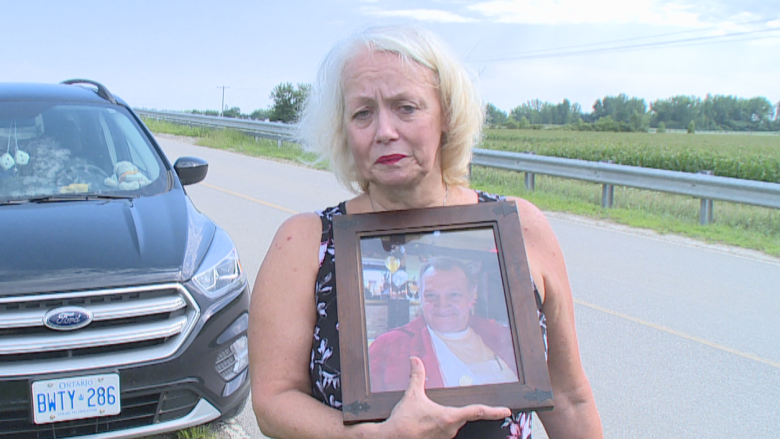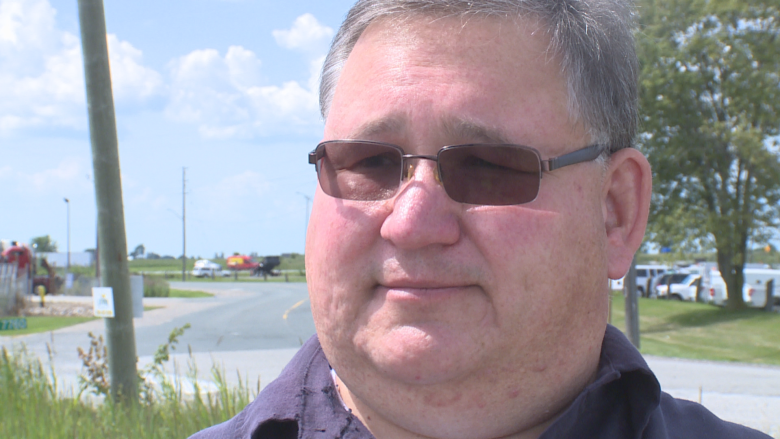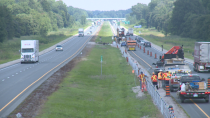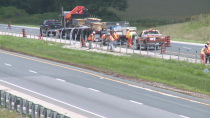Carnage Alley cable barrier a step forward but not a solution says family, friend of victims
Kathleen Reed stands on an overpass above Highway 401 just outside Rodney and what she sees in the distance moves her to tears.
"It's better than nothing — for now," said Reed, staring at a construction crew installing a section of high-tension cable barrier along the highway.
These cable barriers are the first sign of safety upgrades that advocates in southwestern Ontario have spent years pushing for along "carnage alley" — a section of the highway named after a series of fatal collisions over the years.
Transport trucks have crossed the median nine times between 2014 and 2017, killing six people, according to the Ontario Provincial Police.
Reed's fiancé, Gary Lent, was killed when a truck crossed over the median and collided with his transport truck along the section of Highway 401 in February 2017.
Concrete barriers still far off
Reed believes a concrete barrier would have saved her husband's life if it were sitting in the median that day.
"I know in Gary's case, if the accused had of hit that, Gary would still be with me today," she said, holding a photo of her fiancé in her hands.
Concrete barriers are on the way, according to the Ministry of Transportation — but there's a lot of work to be done before they hit the median.
"Building a concrete median barrier will require filling in the open grass median and widening the highway to six lanes, including adding a sewer system and paved shoulders," according to an MTO spokesperson.
The province has started an environmental assessment for the project while it begins work installing high-tension cables along the corridor.
There's $21-million in awarded contracts expected to be completed this summer along the corridor.
Cable barrier installed by 2021
The first 64.7 kilometres of grey, high-tension cable barriers are being installed along the highway this summer, representing 55 per cent of the project.
That will cover the section of Highway 401 between Mull Road outside of Blenheim and Iona Road near Iona Station, as well as Drake Road near North Buxton and Charing Cross Road near Chatham-Kent.
The remaining section of the 118 km corridor will not be finished until the end of 2021 when the highway is finished reconstruction, according to the MTO.
"This is just the beginning," said Reed, who believes it will be three years before the stretch of Highway 401 near Union Road sees high-tension cables and a decade before concrete is put down.
"I can appreciate the cable, it's going to help — but it's not going to solve the problem. Concrete median barriers will."
Advocates continue push
Reed belongs to a group of family and friends that also know people killed in collisions in "carnage alley" known as the Build-a-Barrier group.
Brian French remembers handing out contact cards at a memorial event last summer, urging people to reach out to elected officials and ask for change.
"It was an emotional moment for everyone who was there," said French, who knew Sarah Payne and her daughter, Freya.
They were killed when an alleged drunk driver crossed the median and collided with the Payne's van last August in Dutton.
French was on the bus that traveled to Queen's Park three months after the crash for a meeting he believes convinced the previous government to commit to concrete barriers along highway 401.
He said the current high-tension cable is a "temporary stop-gap" measure because his research shows they're designed to prevent light-sized vehicles from crossing the median — not heavy transport truck corridors.
"[Regular vehicles] probably won't go all the way across and end up in the opposite median, but it will certainly nose into the lane of oncoming traffic and stop if not start to snap back a little bit," said French, adding it depends how the vehicle strikes the cable.
Cables could be moved to other locations
The MTO said high-tension cable barriers will be in place until the concrete barrier is installed.
"Installing high-tension cable is the fastest way to bring significant safety improvements to this section of Highway 401 in Southwestern Ontario with an open grass median," an MTO spokesperson said.
"When the concrete barrier is installed in the future, the cable system can be redeployed to other locations or corridors in Ontario."












